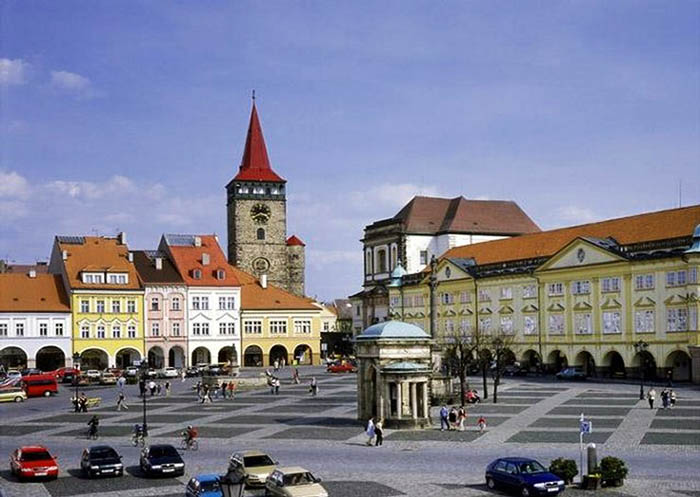
Late Celtic oppidums in the Czech Republic are in most cases located so that they are well protected from the north or the river, or some other obstacle. The most famous of them, and so far the most important, is Hradiste near Stradonice near Beroon on the right (southern) bank of the Beroonka River, covering an area of about 82 ha and located at an altitude of about 380 m above sea level. The richest finds were discovered here, although the place was not systematically explored, but it was excavated in the second half of the last century without any plan. The discovery of the treasure, which consisted of approximately 200 gold coins, immediately attracted attention to this place in 1877, and in a short time – 3 years – one of the most important and richest Celtic centres in Central Europe was dug up and destroyed by self-appointed archaeologists and collectors. Interest in the finds in Stradonitsa was rapidly growing and some enterprising people started making falsifications, which to this day clog various museums in Europe. In most cases, they came from former private collections, of which the Berger collection is now in the National Museum in Prague and the collection of the director of metallurgical plants Gross in the Vienna Museum. The castle mound at Stradonice is located on a cape formed by the confluence of the Gabrowski Creek and the Berounka River. The system of fortifications is little known, only in a few places were found the remains of a dry masonry wall up to 2.5 m wide. The general location gives grounds to assume the presence of the fortified settlement itself and the foothill (tab. XXXV and XXXVII); the findings prove that there was a constantly inhabited oppidum, which concentrated significant production, metal casting, forging (including mass production of iron fibulus), enamel and pottery workshops, etc. The system of fortifications is poorly known. There is no doubt that a coin was minted here, as in addition to coins, the same objects were found as in Manhattan (clay tablets with hollows for casting gold bowls). The findings, dating back to the second half of the last century, clearly indicate a lively trade relationship with the Roman territory, from which various goods, some types of fibula, bronze vessels, gems and amphorae for wine were brought to Bohemia; among the findings were also found frames of wax plates for writing and the first cavalry spurs in our history, as well as keys to door locks. At the end of the last century, the Celts apparently lost power over this oppidum and at the beginning of the new era, it was probably under German rule for some time. Obviously, on the basis of some findings from the period at the turn of the era, archaeologist JL Peach, who published materials about the findings in Stradonitsa, suggested that there was the yard of the German chief Marobud. The Hradiste Community Castle System in Zawiszty near Zbrasław occupies an area of about 170 ha, together with the so-called Shanczy (the hill fort itself is 27 ha). It consists of two parts divided by the Břežanský gully 120 m deep. The actual (southern) fortified settlement passes to the west into a site approximately 150 m above the level of the Vltava River; 50 m above it is the highest point, the acropolis (Figure 29 and Tables XXXVI and XXXVII). The entire fortified settlement is surrounded by a rampart with a moat, some places (at the acropolis) still 6 m high and 25 m wide at the base. The area of the fortified settlement is divided into many terraces, on which, in all likelihood, dwellings stood. On the south side, approximately 100 m lower, there is a basement (“Adamkovo mito”) From the original stone and wooden walls to the present day, only a stone rampart has been preserved, which has not been investigated in detail so far. Traces of settlement were found in the hill fort itself, dating back to the Hallstatt period, and then to the main ooran-zoi by early Latenian time, the last century and its end, and painted ceramics, among other things. Preparations are under way for a systematic study of the settlement, which will take a long time. Connecting shafts through the Břežanský ravine are connected to the hill fort by so-called Shantsy, which is also fortified, so that the whole system of fortifications is extensive. The Shanzes is adjoined by a fortress put forward, linking them to the rest of the area. Some signs indicate that this second part of the system was built quickly and was not completed. This system of fortifications as a whole, with a total length of about 9 km, with several gates, some of which have a wing-shaped (tick-shaped) profile, belongs to the most powerful fortress systems in Central Europe, and its examination in the future will undoubtedly answer many important questions concerning the end of the old and new era. At present, research is being carried out in the extensive onpee-duma in Grazany near Sedlčany on the right bank of the Vltava River, approximately 40 km south of Prague. The Oppidum is located on a promontory between the Vltava River and the Mastnik Creek at an altitude of approximately 400 m above sea level. The place is partially protected by rocky cliffs of the river bank, but mainly by stone walls, with vertical blank strips of poles dug into the ground on the front side. It is therefore not possible to speak of a typical “Gallic wall” in this case. The area of the settlement together with the southern and northern foothills is about 40 ha. In all likelihood, there were four gates in the hill fort. The wings of the gates in the north, already open, were bent inside and formed a passage about 15 m long and 6 m wide (Table XXXVIII). In the gate and on the road to it there are still deep ruts from the wagons, which indicate lively traffic. The fortifications were 5-10 m wide and 4-5 m high. Inside the oppidum there are separate residential objects, some of them in the form of separate yards with a wooden fence. A whole system of dug wells provided the population with water. Apparently, this oppidum was one of the last strongholds of Celtic power in this area. The research that L. Jansová has been doing here for several years has not been completed until now. Another oppidum is located in Nevezice (Mirowice district) at an outcrop near the Vltava River; its wall on the front side was also fortified with vertical beams about 30 cm wide, located about 90 cm apart; behind the wall there was an embankment. Zvikov was probably also one of the fortified sites of late Latenian time. The southernmost Czech oppidum in Třísov (Český Krumlov District) was founded in an area rich in graphite and iron ore, at a favourable location at the curve of the Vltava River and the mouth of the Kremžský Creek at an altitude of about 549 m above sea level. In the western part of the main fortification with a moat there was a gate formed by the wings of the walls bent inside the fortified settlement; the stone wall several metres wide on the outer side was fortified by poles up to 30 centimetres thick, located in metres intervals. The total area of the fortified settlement is about 21 hectares, and according to the findings, it dates back to late Latenian times. The Lhotitska hill fort near Nasa Vrka in eastern Bohemia is one of the smallest in the Czech Republic, but it is surrounded by impressive ramparts and moats, partly preserved to this day. Little has been found there so far, mainly fragments of late Latenian clay vessels. Massive findings of gold coins and ironware in the Kolina region show that an important centre can also be assumed there, the existence of which has not yet been proven. The most significant Moravian oppidum is Stara Hradisko near Okluk on the Drahánské Hill, which is fortified in the same way as the Czech oppidums. The settlement covers an area of about 50 ha. Separate houses stood along the main road, in most cases wooden, without a single plan, sometimes separately, sometimes boring. The fortress walls did not have any houses, apparently cattle were driven there. The inner settlement was also separated from the fence by a stone wall and moat. Systematic research carried out before World War II by I. Bem has not been completed to date, and the results have not been published. However, on the basis of the findings, the oppidum should certainly be attributed to late Latenian time, and it is possible that it lasted a little longer than Stradonitsa oppidum. Some signs suggest that Bratislava in Slovakia may have been an important Celtic centre in late Latenian times, perhaps even Oppidum. Treasures of Celtic coins and extensive pottery workshops were found there, but more detailed research is hampered by the densely built up space in the houses. As for the Zemplín centre in eastern Slovakia, it is not yet possible to determine with certainty whether it dates back to the Celtic era or at least partly to the second half of the last century, when Slovakia was affected by the Dacian pressure. Even at Caesar’s time, there was a wide belt of Celtic oppidums with a high level of civilization stretching from England through France and southern Germany (north to the Main River Basin) and the territory of Czechoslovakia to the Carpathian Basin. Between them there was a lively trade relationship, which also affected the neighbouring regions. The Oppidum civilisation in the area to the right of the Rhine lasted a little longer than in Gaul proper, where Romanisation had already penetrated heavily at the end of the last century. Gradually, however, Roman influence also penetrated into the Celtic oppidums of Central Europe. In the last century, however, the influence of the Celtic civilization on the original Middle European environment reached its climax, largely impacting on it and thus influencing the further development of its culture. The increasing pressure of the Germans, however, led to changes in the political environment. In the last century, quadrilaterals surrounded by a rampart were an interesting phenomenon in part of the Celtic world (Vierskschanzen). We find them mainly in southern Germany, they are concentrated in the area from the upper reaches of the Neckar to the south to the foothills of the Alps, and to the east to the Inns (to Regensburg), therefore, primarily in the region of Baden, Württemberg and Bavaria. In most cases they are square in shape (80 x 80 m and more), their earth walls with ditches and elevations in the corners were built without internal construction. Caesar does not mention them, although they are also found in Gaul south of the lower reaches of the Seine to about the middle reaches of the Loire. There are already more than 250 of them in the Preludehausen area; sometimes two such structures are located at a short distance from each other (Holzhausen in Wolfrathäusen, 100 m away, Niederlaendorf in Rottenburg, 40 m away). It can be assumed that at least in some cases the later construction of the rampart was preceded by a palisade (Golzhausen). The profile of some structures is more complex and the entrance leading to the centre is deepened as a ditch. Lately, the entrance to the centre has been recessed as a ditch. Schwartz attributed the results of new research to them rather a cult character, assuming that they were the precursors of the Gallic-Roman temples. Earlier, some researchers regarded these structures as manors or even enclosures for cattle, and sometimes as military objects. Some of them are located in the Oppidum territory (Donnersberg), while others are close to Roman manors.


Leave a Reply